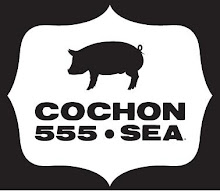
Donning my PR and marketing hat, I must admit, I'm a huge fan of social media. Twitter, Facebook, You Tube, and Blogs. They're inexpensive tools that if utilized well, can explode your business.
The problem? Few restaurants take advantage of social media.
According to Jeffrey Kingman, CEO of Chalkboarder.com, out of 1 million restaurants, fewer than 10% utilize Facebook; less than 6% use Twitter; and a mere 2% of restaurants maintain blogs. To me, this signals a tremendous lost opportunity.
Jeffrey is a former chef, who has become a leader in the social media arena. His company manages accounts for large- to medium-sized restaurant chains and large-scale events, including Coffee Fest and the Northwest Foodservice Show.
I asked Jeffrey to share his thoughts on the restaurants and the use of social media. He agreed, and thanks to Facebook's chat feature, this the conversation that transpired:
Why should restaurants care about social media? And what are the advantages to implementing a social media program?
It's a fundamental shift in communication. We've adopted communication tools that allow us to do so much more "on the go" than we could just two years ago.
Yet, the communication methods offered by most restaurants are circa 2005. They have flat, static websites that never change. Customers call to make a reservation, but they have to leave it on the restaurant voicemail. In the smartphone/social media era, these outmoded methods create unnecessary obstacles for customers.
Playing devil's advocate re: social media..."So what? What does that mean to my business?"
Today's consumer, with all these tools, demand much more ease in communicating with businesses.
What does that mean to your business, if you don't take advantage of these tools? You'll loose customers and business volume.
Savvy restaurateurs are taking advantage of today's communication tools, and customers are responding to those businesses that offer ease of entry.
The fastest growing segment of social media and smartphone (mobile tech) adoption is aged 40-65. That's the discretionary income population.
What key things are customers looking for in social media interactions?
1. A much easier time communicating with restaurants, on the customer's schedule--not the restaurant's schedule.
2. Peer reviews -- not reviews by random people on Yelp, but rather, what their friends are saying about restaurants.
3. The backstory for restaurants -- what is unique about the restaurant? Why should I go there?
4. A desire to become part of a community, both online and in store.
Many restaurants are hesitant to embrace social media. What's that mean to their bottom line?
I think a lot of restaurants are missing the mark by "couponing" offered by Groupon, etc. Most customers aren't shopping on price -- they're shopping for experience and community.
What's the bottom line for a restaurant's telephone?
When phones, then fax machines, then computers came out -- we saw the same trepidation by the restaurant industry...what does this new technology mean to my bottom line?
Social media is a communication tool. Yes, it takes time - time to gather the knowledge on how to do it right and time to actually do it. But if the vast majority of your customers can be reached via mobile devices through social media, why wouldn't a restaurant take advantage of that?
Let's face it...do restaurant customers hear about offerings through newspapers anymore?
Do they hear about restaurants through radio or TV?
A website doesn't move; it sits there.
An e-mail address doesn't move; it sits there.
But if a restaurant is producing great content, great stories, and fun video content and sharing that -- now they're dynamically producing messages that can "swim" on their own.
Building the community online not only depends on producing good messaging -- you also have to reach out in-store -- make it easy for your existing and in-store customers to know that you are on Facebook, Twitter, and You Tube.
How do you reach out in-store?
Several ways -- for starters, you could put the Facebook logo on your guest check print out and in the corner of the menu.
If you're a casual spot -- put up table tents.
The Herbfarm (the only five star restaurant north of San Francisco and west of Chicago) just experimented with QR codes on their menu. Customers were able to snap a picture of the code on their smartphone and get the entire backstory of the entree: where the ingredients came from, preparation methods, etc.
It's all about being creative.
What are QR codes?
Quick Reads
A QR Code is a matrix barcode (or two-dimensional code), readable by QR scanners, mobile phones with a camera, and smartphones. The code consists of black modules arranged in a square pattern on a white background. The information encoded can be text, URL, or other data.
Besides the Herbfarm, what other restaurants are utilizing social media well?
Multi-unit, look at Genghis Grill...they're integrating a full matrix of digital/social media into a year-long campaign culminating at South by Southwest.
Tell me more about the Genghis Grill social media campaign.
Genghis Grill is a muti-state, multi-unit operation, located mostly in the Midwest and East Coast.
They're conducting a music band competition (like rock bands), with competitions in 10 metro areas.
The community gets to nominate the bands they want to see compete.
Then there is a band-off.
The ultimate finals are held at the Genghis Grill in Austin, Texas during South by Southwest. Voting happens all the way through social media.
If you want a better description, I'd suggests you e-mail or Tweet Paul Barron -- he structured the strategy for Genghis Grill.
Okay, so that's what a large-scale restaurant operation can do with social media. Who's doing well from an independent restaurant perspective?
Back in the Northwest, Gabriel is doing a great job for Le Pigeon [via Facebook]. He's personal online. He's active, messaging frequently.
All the profile information is updated to include images.
He tells personal anecdotes from his adventures as a chef/restaurateur, while sprinkling in marketing messages of menu changes.
Most importantly -- it's obvious he's having fun.
What other restaurants/chefs are utilizing social media successfully?
Rick Bayless [Frontera Grill and Topolobampo in Chicago] and Ron Zimmerman at the Herbfarm are heavy users of Twitter -- with huge followings.
Rick Bayless and Ron Zimmerman are prolific users of Twitter. While I love their content, I don't want to scare new users by thinking they need to Tweet that much! Who else?
On Facebook, I see a lot of descent messaging by Susan Feniger, David Ford, Floyd Cardoz, and Thomas Keller.
Thomas Keller's on Twitter too. He uses his camera a lot, which I love. How important is imaging in social media?
Harvard put out a study that found messages with images were opened 80% more than messages with no image.
I love it when restaurants show behind the scene images during prep or talk about producers who just dropped off foraged mushrooms, for example.
I'm a food geek [and former chef]. Images of production, and in detail close ups capture me more than a finished plate on a counter.
Can you talk about the importance of engagement?
If I can describe a mentor...I think it will illustrate this answer.
Riccardo Spaccarelli, thirty-year proprietor of a good Northern Italian restaurant in Lake Oswego, OR, builds his village every night.
At 6 PM, he puts two wine glasses and a bottle of wine in his left arm. Then he walks the dining room for the next three hours.
He visits with every customer that comes in, every night.
Those he doesn't know, he gets to know. "Hows your boy at school?" kind of thing.
Social media is the ability to visit your customers "tableside" online.
A restaurateur could visit "tableside" after the dining room has closed, if they're too busy during the shift. Grab a glass of wine, get your pj's on, and talk with your customers for an hour.
For me, two benchmarks for social media are: Humphrey Slocombe in San Francisco and Tidbit Bistro in Seattle. On Twitter, I had people from Germany and New York recommending Tidbit Bistro. "You're from Seattle? Do you know about Tidbit Bistro?" This tiny bistro has 17,000 followers! No Food Network profiles, no national media to speak of. They built a large, loyal following organically through social media.
I haven't followed either of those!
Humphrey Slocombe is a star on Twitter. The person maintaining their account is hilarious!
You know, if the owner or the chef is not an extrovert -- the person doing their social media needs to be. Maybe not in person, but definitely online.
When I was in San Francisco last year, I made a point of visiting Humphrey Slocombe just because of their Twitter account. They have over 300,000 followers! And this is an ice cream shop. I was there on a fall day between 3 - 4 PM and they had a steady flow of customers the entire time.
Damn.
Okay, before I cut you loose, can we talk about what NOT to do on social media?
1. Never disrespect a customer.
2. Minimize bad situations in person or on the phone.
3. Be transparent. If you screw up, don't erase it. Just apologize, correct, and move on.
4. Stay away from "Tonight $1 hot wings" advertising. (Social media is social--it's not the place for old-school advertising.)
5. When someone tags you in a message -- always get back to them with a thank you for doing business.
Who should manage your social media?
If the restaurateur or the Chef has the energy or time (and is extroverted), they should.
If they are too big or too busy, they should delegate -- and not to a 21 year old.
The delegation should go to someone savvy and with great communication skills, who can deal with delicate situations in addition to promoting non-delicate positives.
If a restaurant doesn't feel they have someone on staff for that, a good social media pro can be a great value.
Finding a pro isn't difficult -- just inquire of the local Social Media Club.
Outsourcing social media can be a huge advantage, and extremely valuable. What's the going rate for hiring a social media pro?
It depends on the project -- but here's a good comparison...what would you pay a sous chef or an assistant manager for their hourly time?
You're paying someone to be the public face of your business.
A good sous chef is always learning new skills, techniques, etc. The person handling your social media should be doing the same.
A good social media pro is always staying up on the latest mobile technology and social media theory.
If a restaurant outsourced their social media, ideally, how many hours/week would you expect them to work?
It depends on the project. An independent restaurant, moderately ambitious in social/mobile marketing, that does $1-2 million a year should expect to put in an hour a day.
***
Want to get in touch with Jeffrey? Find him here:
Twitter: @JeffreyJKingman
Facebook: www.facebook.com/jkingman
Linked In: www.linkedin.com/in/jeffreykingman


 Skip the over-the-door dormer. How 'bout a bookshelf?
Skip the over-the-door dormer. How 'bout a bookshelf? This dining room does double duty as a library.
This dining room does double duty as a library. While this is the more realistic solution, the minimalist in me sees nothing but a wall of clutter. What to do?
While this is the more realistic solution, the minimalist in me sees nothing but a wall of clutter. What to do? Here, a floor-to-ceiling curtain conceals bookshelves, and provides a solid punch of color.
Here, a floor-to-ceiling curtain conceals bookshelves, and provides a solid punch of color.
 A neutral color palate also helps minimize the "clutter" effect. But really? Who has books in just white, beige and black? Designer fantasy.
A neutral color palate also helps minimize the "clutter" effect. But really? Who has books in just white, beige and black? Designer fantasy. Here, the bookshelf serves as the room's focal point and provides the only visible color/object of interest.
Here, the bookshelf serves as the room's focal point and provides the only visible color/object of interest. 



 Imagine casting your gaze out on this charming sokak in old Istanbul. Ahh.....
Imagine casting your gaze out on this charming sokak in old Istanbul. Ahh.....
 First step, a site visit to Station Number 39.
First step, a site visit to Station Number 39. This is a brand new LEED-certified station. See the tower on the right? That's used for high-rise rescue training.
This is a brand new LEED-certified station. See the tower on the right? That's used for high-rise rescue training. Every station is different, but here, an average shift includes four firemen. Downtime at the kitchen table. See the lockers in the background?
Every station is different, but here, an average shift includes four firemen. Downtime at the kitchen table. See the lockers in the background? I like this guy already!
I like this guy already! The new Seattle fire stations are equipped with large kitchens and stainless steel appliances. I kept teasing them, "Why do four guys on shift need two full-sized refrigerators?" Pictured is my pal Mindy, the dream maker.
The new Seattle fire stations are equipped with large kitchens and stainless steel appliances. I kept teasing them, "Why do four guys on shift need two full-sized refrigerators?" Pictured is my pal Mindy, the dream maker.









 Station 39, A shift crew.
Station 39, A shift crew. The dream takes shape...but not without a hitch. Two hours before dinner, we realized the folding tables & chairs were no longer on the premises. Scrambling for a solution, the guys moved the table from the kitchen, we grabbed every available (office) chair, and Mindy raced home to retrieve a card table and chairs.
The dream takes shape...but not without a hitch. Two hours before dinner, we realized the folding tables & chairs were no longer on the premises. Scrambling for a solution, the guys moved the table from the kitchen, we grabbed every available (office) chair, and Mindy raced home to retrieve a card table and chairs.





 And for the grand finale...a group shot! In uniform are the B crew firemen from Station 39. My buddy Mindy is there on the right. Back row includes the auction winners and 2 of the calendar firemen. That's Tori in the front row.
And for the grand finale...a group shot! In uniform are the B crew firemen from Station 39. My buddy Mindy is there on the right. Back row includes the auction winners and 2 of the calendar firemen. That's Tori in the front row. 




















